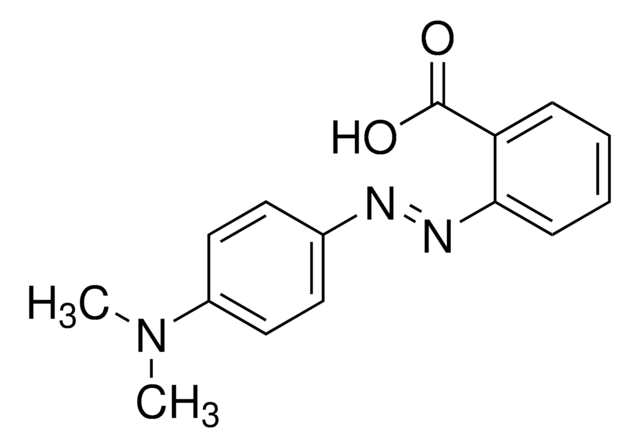1.01322
Methyl orange (C.I. 13025)
pH indicator, ACS, Reag. Ph Eur
Synonyme(s) :
Methyl orange (C.I. 13025), 4-Dimethylaminoazobenzene-4′-sulfonic acid sodium salt, Gold orange, Helianthine, Orange III
About This Item
Produits recommandés
Nom du produit
Methyl orange (C.I. 13025), indicator ACS,Reag. Ph Eur
Qualité
ACS reagent
Niveau de qualité
Agence
reag. Ph. Eur.
Forme
solid
Puissance
60 mg/kg LD50, oral (Rat)
Perte
≤5% loss on drying, 110°C
pH
6.5 (20 °C, 5 g/L in H2O)
Pf
>300 °C
Masse volumique apparente
200‑400 kg/m3
Température de stockage
2-30°C
InChI
1S/C14H15N3O3S/c1-17(2)13-7-3-11(4-8-13)15-16-12-5-9-14(10-6-12)21(18,19)20/h3-10H,1-2H3,(H,18,19,20)/p-1
Clé InChI
IETWCRRCPURZOC-UHFFFAOYSA-M
Application
- Plant-assisted green preparation of silver nanoparticles using leaf extract of Dalbergia sissoo and their antioxidant, antibacterial and catalytic applications.: This research utilized Methyl Orange as an indicator in the green synthesis of silver nanoparticles using Dalbergia sissoo leaf extract. The study highlighted its catalytic application in dye degradation, demonstrating the environmental benefits of plant-assisted nanoparticle synthesis (Khatun et al., 2024).
- Dye Degradation and Sulfur Oxidation of Methyl Orange and Thiophenol via Newly Designed Nanocomposite GQDs/NiSe-NiO Photocatalyst Under Homemade LED Light.: This study focused on the efficient photocatalytic degradation of Methyl Orange using a novel nanocomposite photocatalyst under LED light, presenting significant advancements in photocatalytic materials for wastewater treatment (Srivastava et al., 2023).
- Bryophyllum pinnatum leaf extract mediated ZnO nanoparticles with prodigious potential for solar driven photocatalytic degradation of industrial contaminants.: The research demonstrated the synthesis of ZnO nanoparticles using Bryophyllum pinnatum leaf extract and their application in the photocatalytic degradation of Methyl Orange, showcasing a sustainable approach to tackling industrial pollutants (Dhiman et al., 2023).
- Light driven Aspergillus niger-ZnS nanobiohybrids for degradation of methyl orange.: This paper explored the use of Aspergillus niger-ZnS nanobiohybrids for the degradation of Methyl Orange, emphasizing the potential of biogenic approaches in enhancing photocatalytic efficiency (Priyanka & Lens, 2022).
- Bacterially driven cadmium sulfide precipitation on porous membranes: Toward platforms for photocatalytic applications.: This study utilized Methyl Orange to assess the photocatalytic efficiency of cadmium sulfide precipitated on porous membranes by bacteria, proposing a novel method for creating photocatalytic platforms for environmental applications (Marusak et al., 2018).
Remarque sur l'analyse
Appearance of solution: passes test
Loss on drying (110 °C): ≤ 5
Transition range (according to ACS): passes test
Sensitivity test: passes test
Mention d'avertissement
Danger
Mentions de danger
Conseils de prudence
Classification des risques
Acute Tox. 3 Oral
Code de la classe de stockage
6.1C - Combustible, acute toxic Cat.3 / toxic compounds or compounds which causing chronic effects
Classe de danger pour l'eau (WGK)
WGK 3
Point d'éclair (°F)
Not applicable
Point d'éclair (°C)
Not applicable
Certificats d'analyse (COA)
Recherchez un Certificats d'analyse (COA) en saisissant le numéro de lot du produit. Les numéros de lot figurent sur l'étiquette du produit après les mots "Lot" ou "Batch".
Déjà en possession de ce produit ?
Retrouvez la documentation relative aux produits que vous avez récemment achetés dans la Bibliothèque de documents.
Les clients ont également consulté
Notre équipe de scientifiques dispose d'une expérience dans tous les secteurs de la recherche, notamment en sciences de la vie, science des matériaux, synthèse chimique, chromatographie, analyse et dans de nombreux autres domaines..
Contacter notre Service technique









